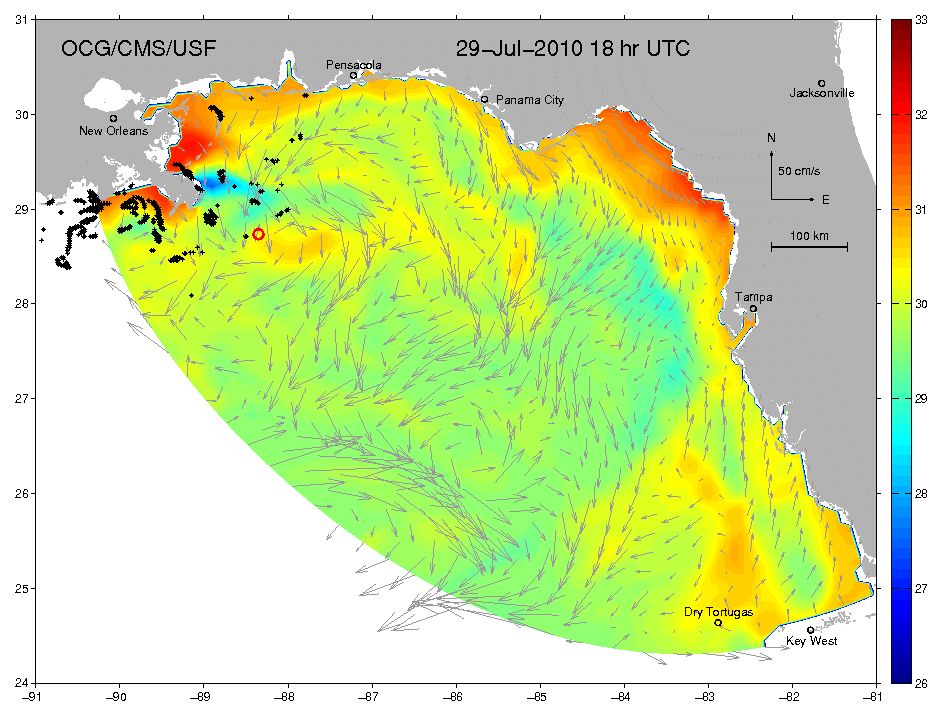An update from Jeff Masters:
Long-range prospects for oil to enter the Loop Current and hit the Keys
Posted by: JeffMasters, 3:21 PM GMT on May 06, 2010
The oil slick from the April 20 explosion and blowout of the offshore oil rig Deepwater Horizon is moving little, thanks to the light winds of 10 knots or less that have affected the northern Gulf of Mexico over the past few days. According to the latest NWS marine forecast, winds will remain light through Saturday, which should result in little transport of the oil slick. The latest trajectory forecast from the NOAA Office of Response and Restoration continues to show that the mouth of the Mississippi River and the Chandeleur Islands will be the only land areas affected by the spill over the next two days.
On Sunday, the winds will begin increasing and shifting to the southeast. The latest run of the GFS model shows that this will be a week-long period of southeast winds, with wind speeds at times reaching 20 - 25 knots. These winds will threaten to bring oil to a large portion of the Louisiana coast, including regions of the central Louisiana coast west of the mouth of the Mississippi River. The Mississippi and Alabama coasts will also be at risk next week, but the risk to the Florida Panhandle is lower.
A major concern with the Deepwater Horizon oil spill is the possibility for the oil to move southwards and become entrained into the mighty Gulf of Mexico Loop Current, which would rapidly transport the oil through the Florida Keys, impacting northwest Cuba, South Florida, the western Bahamas, and the U.S. East Coast all the way to Cape Hatteras, North Carolina. However, there is no immediate danger of this happening. The latest forecast of Gulf currents from the NOAA HYCOM model (see also this alternative view of the HYCOM ocean current forecast) indicate that the currents will not be favorable for pulling any oil southwards into the Loop Current over the next five days. Oil will have to travel approximately 100 miles to the south-southeast to get entrained into the Loop Current, and we probably would need a 2+ day period of strong winds out of the north for this to happen. The long-range GFS model indicates that the earliest this might happen is 10+ days from now. As summer gets closer, the incidence of cold fronts making it far enough south to bring an extended period of offshore northerly winds to the Gulf of Mexico decreases. I think there is a 40% chance that the next cold front capable of pushing oil into the Loop Current will arrive by the end of June. However, I think it is more likely that the next such front will not arrive until October, when fall comes.
That makes a tropical storm or hurricane as perhaps the most likely weather event to push oil into the Loop Current over the next few months. A tropical storm hitting the Panhandle of Florida would do the trick, by bringing northerly winds over the oil spill location, thanks to the counter-clockwise flow of air around the storm. Looking ahead to June, June tropical storms tend to form in the Gulf of Mexico, and we've been averaging one June storm every two years since 1995. This year, the odds of a June Gulf of Mexico storm are probably a little lower than usual. While Gulf of Mexico sea surface temperatures are near average, wind shear from our lingering El Niño will probably be above average. Since 1995, there have been three June tropical storms in the Gulf of Mexico that have followed a track capable of pushing oil into the Loop Current. These storms were Hurricane Allison of 1995, Tropical Storm Allison of 2001, and Tropical Storm Arlene of 2005. Taking into account all these factors, I'll give a 20% chance that we'll get a June tropical storm capable of transporting oil into the Loop Current."
http://www.wunderground.com/blog/Jef...?entrynum=1475
A USF plume transport model:

The red, warmer waters below the release represents the loop current.
There is a time animated version of the model display at:
http://ocg6.marine.usf.edu/~liu/Drif...atest_roms.htm
.